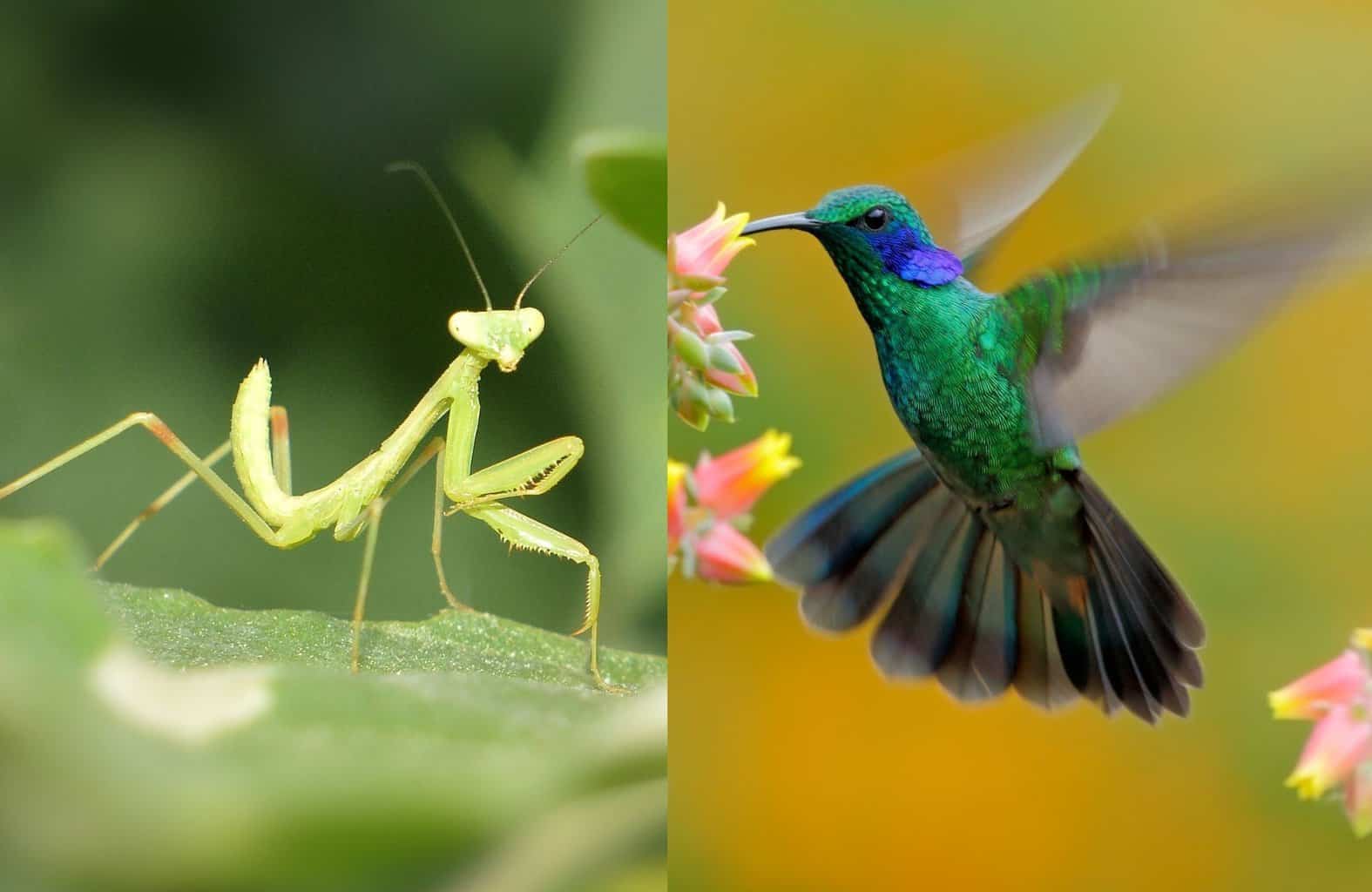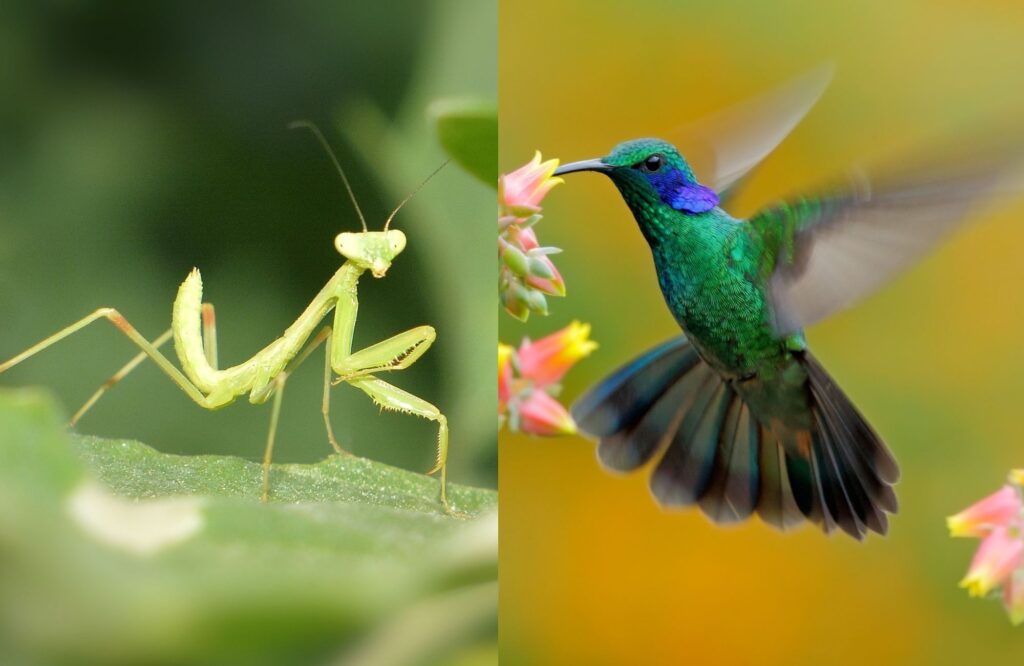If you have hummingbirds in your garden, you will naturally want to keep your feathered friends safe.
Making sure that you understand what can pose a threat to these amazing birds and looking out for hummingbird killers can help make sure you play your part in protecting hummingbirds that live in or visit your area.
If you see praying mantis in your garden or your area, you may wonder whether these pose a threat to hummingbirds—so check out this article for everything you’ll need to know!
Can Praying Mantis Kill Hummingbirds?
Unfortunately, praying mantis can indeed kill hummingbirds, and will do so on occasion. So if you see a praying mantis on or close to a hummingbird feeder, this is something that you might wish to do something about!
A large praying mantis is indeed capable of catching hummingbirds, so this can become a serious issue.
If one of these predators finds and fixates on a feeder, it may come back regularly to try to nab a hummingbird once more—especially if there are few other food sources around.
Praying mantis of around 4 inches or more in length (as large or larger than the hummingbirds you are likely to see) are large enough to kill hummingbirds.
Smaller individuals are unlikely to be able to do so. But if in doubt, it could still be a good idea to relocate the individual from a hummingbird feeder if you are concerned.
The mass introduction of praying mantis over the US has unfortunately contributed to the increase of praying mantis attacks on hummingbirds, in areas where these larger insects would not usually be found.
Scientists have found that praying mantises catch birds on every continent except Antarctica. Twelve different mantis species caught and killed birds (mostly hummingbirds), including both native species like the ruby-throated hummingbird and introduced species in the United States.
Approximately half of the U.S. captures were by native mantids, mostly in the west, and the other half were by introduced species, mostly in the east.
In the scientific survey, the ruby-throated hummingbird, the only hummingbird that lives east of the Mississippi River, was the most frequently reported victim.
Though perhaps this is because of the high numbers of hummingbird lovers attracting these birds to their gardens, creating ideal hummingbird habitats, and placing feeders in the areas where these particular hummingbirds are found.
What Are Praying Mantis?

Praying mantises are insects in the Mantodea order. They are found worldwide in temperate and tropical climates and are closely related to termites and cockroaches.
Often confused with other insects like grasshoppers or stick insects. They are ambush predators which feed on a wide range of prey.
These insects take their name from their prominent front legs, which are bent and held together in a way that makes them look as though they are in a position of prayer.
But despite the peaceful nature that this stance might imply, praying mantis are ferocious predators, carnivores that have adapted to become formidable against their prey.
How Does a Praying Mantis Catch Its Prey?
A praying mantis will sit, often well camouflaged among plants, waiting to ambush its quarry. They use their front legs to snare their prey, using their quick reflexes, with movement often too quick to see with the naked eye.
Their legs have spikes that pin their prey in place. Gruesome but true, a praying mantis will spear a hummingbird or other prey with these spikes in order to secure it.
Very few hummingbirds will be able to escape without human agency once a praying mantis has it in its grasp.
Do Praying Mantis Eat Hummingbirds?
Most of the time, these insects will eat other insects, like moths, flies, grasshoppers, and crickets. When possible, they will tend to preferentially eat smaller, soft-bodied prey.
However, they are also known to catch and eat small lizards, frogs, mice, and even others of their own kind. And on occasion, will grasp and kill small birds like hummingbirds too.
But they will usually only attempt to catch larger prey like hummingbirds if they are desperate. So if hummingbirds are being captured and killed on a regular basis, this could be a sign that there is a shortage of other easier, suitable prey around.
A hungry mantis, in wait for fast-flying prey, may also occasionally lunge for a hummingbird before it realizes the size of the prey.
Once the individual mantis has its prey in its grasp, it will eat the edible portions of the prey—while it is still alive—before discarding the inedible remains with a shake of its front legs.
They will often eat the brain tissue and other organs of the bird before discarding the feathers, bones, and other portions that they cannot eat.
Having hummingbirds killed and eaten by praying mantises is not, in reality, all that common. But since these can predate hummingbirds on occasion, it is a good idea to do something about it if you spot one close to hummingbird feeding areas in your garden.
How To Protect Hummingbirds From Praying Mantis
Place hummingbird feeders out in the open, to reduce the places where praying mantis and other hummingbird predators can hide.
This will also mean that hummingbirds can get a clear view of the feeders and spot any dangers that may be lurking there.
If you see these insects sitting on feeders, you might also consider covering the feeder with a special dome or wide bird feeder cover, which will discourage praying mantises while still allowing good access for your hummingbird visitors.
Praying mantis are often attracted to feeders initially by the presence of smaller flying pollinators—like bees or wasps. So keeping these flying insects away should reduce the chances of a praying mantis being drawn to a feeder, and keep hummingbirds safe.
To keep bees and wasps away, remove any yellow colors and paint feeders red, or choose a red feeder in the first place. Add a bee guard to deter these flying insects.
Remember, hummingbirds are drawn to red feeders and red or other bright flowers with tubular or trumpet-shaped forms. While bees and wasps are drawn to yellow.
And most of all, make sure that you always clean your feeder on a regular basis. Make sure that sweet hummingbird food is well contained, and that there are not any leaks.
Clean up any spills as soon as possible so you don’t have unwanted guests on your feeders.
Remember, to protect hummingbirds from praying mantis, the key is to keep them away from feeders and other key places of hummingbird habitat that they frequent.
But you don’t necessarily want to get rid of these creatures from your garden altogether. They have an important place in the garden ecology, are part of the food chain, and can be handy around your vegetable garden.
They keep down the excess insect population and are good in the garden for insect control, since they prey on aphids, for example, to keep crops safe.
So if you spot a praying mantis on or near a feeder, simply use a stick to remove it and place it somewhere else in your garden, far away from the areas where hummingbirds are commonly found.

